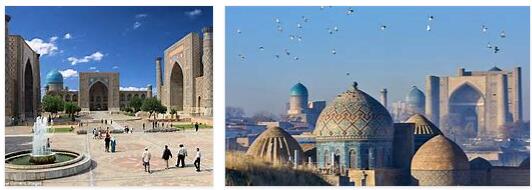Descending from the merger that took place in the century. Among the already sedentary indigenous groups and nomadic Mongolian tribes, the Uzbek population was later subject to the sovereignty of various khanates, among which from the eighteenth century those of Buhara, Samarkand and Kokand prevailed. With the conquest of the latter by the Tsarist troops in 1876, the region then entered the Russian Empire and followed each subsequent historical event. Contended, in the aftermath of the Bolshevik Revolution, by the Red Army and from the counterrevolutionary and nationalist forces (the Basmachi movement) supported by Great Britain, the constituent territories of today’s Uzbekistan acquired the status of a Soviet Socialist Republic in October 1924 through a composite process of border definitions that ended in the following decade (1936). In the 1930s, Tashkent became the country’s capital. Having come very backward in its socio-economic structures to inclusion in the USSR, Uzbekistan subsequently experienced a certain agricultural and industrial development, stimulated by the immigration of skilled workers from the European Soviet area and later, with the Second World War, also from the transfer of plants threatened by war events, However, in the following decades it suffered significant environmental damage (chemical pollution of the territory, soil erosion and reduction of the surface of the Aral Sea, as well as problems relating to the storage of radioactive material) which have aroused growing concern in the local population. In 1983, the new local Communist Party secretary I. Ousmankhodgipaev unleashed a cotton-related scandal that resulted in the arrests and trials of thousands of officials across the USSR. The climate of tension between the Uzbeks, mostly Sunni Muslims, and the anti-clerical policy of Moscow and the Russian minority led to violent clashes between 1989 and 1990. Uzbekistan proclaimed independence on August 31, 1991, as a result of the dissolution of the USSR, induced by the failed Moscow coup of the same month. At the same time as the referendum that sanctioned this act (29 December 1991), President Islam Karimov, formerly leader of the Communist Party (now the People’s Democratic Party, PDP), elected to this office in March 1990. Political action has been oriented towards the consolidation of relations with foreign countries, especially with Central Asian countries and with Turkey, with which Uzbekistan joined the Economic Cooperation Organization. Visit clothesbliss.com for Asia modern history.
While taking hold of reborn nationalistic sentiments and tending to make Uzbekistan (the most populous in the region) the leading country in the area, the government refused to support orientations in favor of Pan-Turkism or fundamentalism. religious, moreover represented by an active Islamic Revival Party (with a strong following in some areas, mainly in the Fergana valley). Membership of the CSI it was in any case immediate (21 December 1991) and it was followed by an attempt to liberalize the economy in a rather radical way. Student riots against the sharp rise in the cost of living took place in Tashkent in January 1992, provoking a robust crackdown. In the following July a new Constitution was approved, made public in September, which formally established a multi-party system, but it remained substantially on paper due to the PDP’s resistance to accepting real political competition. This situation was matched by an exacerbation of the totalitarian character of the regime led by Karimov. The lack of democracy was evident in the vote for the election of the new legislative assembly, the Oli Majlis, which replaced the Soviet supreme. Two political formations participated in the two-round consultation between December 25, 1994 and January 22, 1995: the former Communist People’s Democratic Party (PDP) and its ally Motherland Progress Party (PPM). The new assembly was made up of 86% ethnically Uzbeks, who represent 71% of the population. In May 1995, the Oli Majlis renewed the mandate in the government led by Prime Minister Abdulashim Mutalov. As for foreign policy, Uzbekistan has been reluctant to accept Russia’s impositions, refusing to engage more in the Commonwealth of Independent States. Throughout the last decade of the twentieth century, the political life of Uzbekistan was characterized by this evident dichotomy: BORN, July 1994) and internal neo-authoritarian pressure. In 1998 the president supported the Russian Federation in the war against Chechnya, unleashing the secessionist policy of the Islamic Movement of Uzbekistan (MIU), accused by the government of several terrorist attacks. In the January 2000 elections Karimov was re-elected. In 2001, the government ceded the use of an airbase to the US military, in exchange for financial aid and the opening of credit from the IMF. In March 2004 the country was hit by the MIU guerrillas, contrary to the government’s pro-US policy. In May 2005, the conflict between Islamic rebels and the police forces re-erupted in Andijan, causing deaths and injuries. In 2007 an agreement on Uzbek gas supplies to Russia, it linked the two countries even more and an alliance pact between Karimov and the Russian government caused the removal of the US military from the Uzbek base of Karshi Khanabad. In December of the same year, presidential elections reconfirmed the incumbent president. In December 2009, elections for the renewal of parliament were held, dominated by the four pro-government parties.
